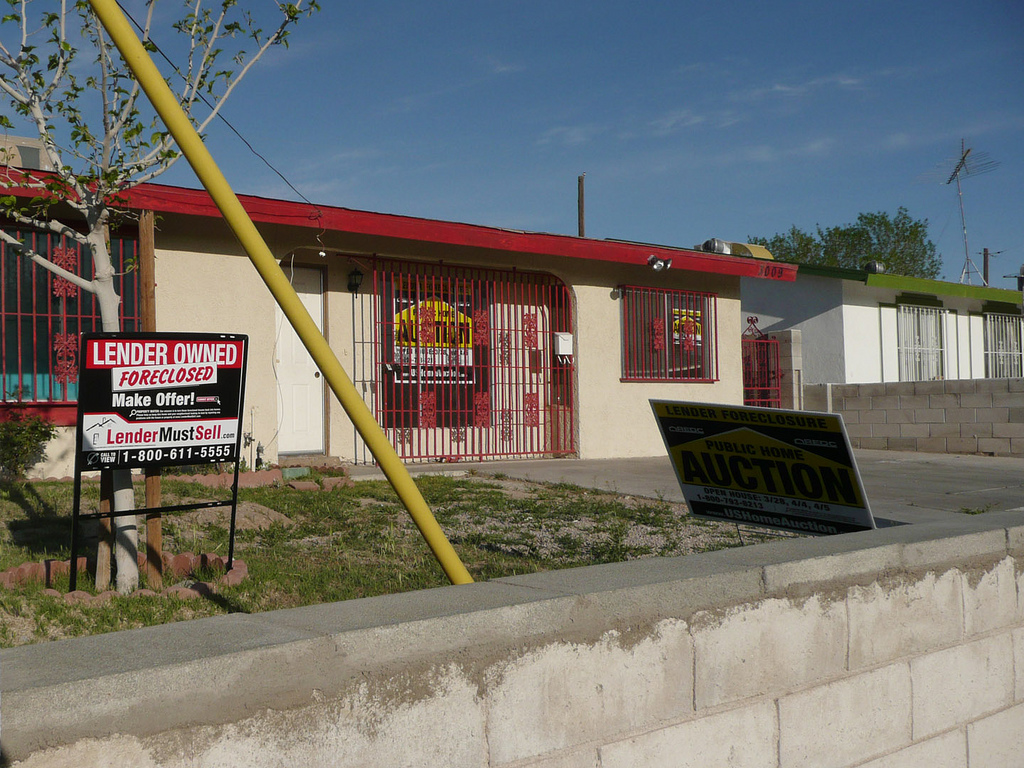
When Americans discuss solutions to the housing crisis, the conversation often turns to big players—the Obama administration, Congress, the Federal Reserve, the banks. But foreclosures happen at the local level, and they have devastated some communities. Even with a problem as big and complicated as the foreclosure crisis, individual citizens can ease the damage to their communities. In advance of a Zócalo event in Phoenix, “How Do We Rebuild Neighborhoods After Foreclosures?”, we asked experts in community-building and real estate: What, if anything, can a person living on a street of foreclosed houses do to help the neighborhood bounce back?

Too many neighborhoods that have seen multiple foreclosures remain in serious trouble, with neglected or vacant properties creating eyesores, degrading the value of neighboring homes, and attracting crime. To solve such problems, the remaining neighbors need to be vigilant and work together.
In a word: raise hell. If a foreclosed property needs attention, find out who owns it. You can generally do this by contacting the county officials in charge of property taxes and related issues. You can find a step-by-step guide here.
Then, contact the bank and insist that they address any problems. If you don’t get a helpful response, contact your local elected officials, who may be able to fine the owner for failure to maintain the property. You can also consider calling the problem to the attention of local news media: Sometimes a bit of public embarrassment can help folks see the light. A complaint to the Consumer Financial Protection Bureau is another option.
If your area doesn’t have a vacant property registry, work with neighbors and local officials to establish one. That will help ensure that contact information for absentee owners is available to officials and the public.
Sometimes, even this sort of aggressive push will take a while to produce results. While no one wants to relieve negligent owners of their responsibilities, homeowners may need to join together on their own to address conditions that are degrading the neighborhood. Most of all, neighbors will need to pull together and not give up!
Preeti Vissa is Chief Operating Officer at The Greenlining Institute.

The best thing to do is to act to prevent more foreclosures. A surprisingly high proportion of homeowners facing foreclosure never talk to anyone. They may be ashamed. They may not know whom to call. Tell your neighbors there is nothing to be ashamed of. Foreclosures are like an epidemic sweeping through our communities. Some people fall victim even though they did everything right. They may have simply bought their house at the wrong time, lost their job, or fallen ill.
Spread the word that free foreclosure counseling is available through NeighborWorks, a national network of community development and affordable housing organizations. Counselors can help them avoid foreclosure. They know how to negotiate with the banks, modify loans, and access government resources.
What can you do once foreclosures have already occurred on your block? First, recognize there is little you can do about the immediate negative spillover effects of foreclosures. Research has consistently shown that every property within about one-eighth of a mile (660 feet) of a foreclosure loses 1-2 percent in value. Foreclosures harm the local schools by pulling kids out of the classroom, tear at the community fabric, and put fiscal pressure on local governments.
In a strong housing market, where demand generally outstrips supply, most foreclosed homes will be put right back on the market and the neighborhood should bounce back right away or in a few years. Don’t panic. Be patient.
In weak markets, concentrated foreclosures can cause a reinforcing spiral of decline. In such cases, neighbors need to band together, form a neighborhood association or a community development corporation, and enlist the aid of governments and nonprofits. In the most distressed neighborhoods, it may be necessary to tear down vacant homes and concentrate resources on the strongest blocks where the market can be rebuilt. But the important point is you can’t do it alone. Neighbors need to band together, or they will fall separately.
Todd Swanstrom is the Des Lee Professor of Community Collaboration and Public Policy Administration at the University of Missouri-St. Louis. The Des Lee Endowment supports the Creating Whole Communities Initiative that strives to create great neighborhoods throughout the St. Louis metro area.
Margaret Weir
Reach out to local governments, nonprofits and neighbors, on everything from maintenance to demolition

Foreclosure is not just a personal calamity; a whole neighborhood can fall into crisis if homes languish in foreclosure for prolonged stretches of time. A single foreclosure reduces the property values of surrounding homes and increases the crime rate in the affected neighborhood. In worst-case scenarios, multiple foreclosures can set off a downward spiral whose effects are felt for a very long time. Stretches of Detroit and Chicago, abandoned for 50 years after the 1960s urban riots, offer a grim testament to what can happen when vacant properties are left to rot.
Can individuals do anything to head off the problems that foreclosures can trigger? Together with neighbors, local nonprofit organizations, and city governments, there are some steps you can take.
You can gain permission from the city to perform basic maintenance on a foreclosed house—such as mowing the lawn. If you are the only house on the block not in foreclosure, however, this can quickly become overwhelming. You need to reach out to the broader neighborhood: They, too, have a stake in what happens on your block. Mobilize neighbors to monitor the area for code violations and signs of vandalism. At the first sign of trouble, a coordinated barrage of phone calls can serve to let city officials know that there is an engaged community watching and expecting a response. If you live in an area bound by a Home Owners Association, make sure the HOA is enforcing maintenance standards on foreclosed properties.
Contact local community development corporations or other nonprofit housing organizations; they can become critical allies. These organizations have experience in buying distressed properties, repairing them, and getting them back on the market. They can tap into government funds available for these purposes. In some places, however, private investors are snapping up foreclosed homes before CDCs can take action. Purchase by an investor may not signal the end of your problems: some investors are simply seeking to “milk” distressed properties for rental income. Be vigilant that new investor/owners are maintaining their new property.
When foreclosed homes have become too deteriorated to sell, demolition, and the creation of local park space or even a vacant lot may be the best solution. Local governments across the country are seeking to gain powers to create “land banks” that make it easier for them to demolish deteriorated properties and find new uses for them.
Margaret Weir is Avice M. Saint Chair in Public Policy and a professor in Political Science and Sociology at the University of California, Berkeley. She directs the MacArthur Foundation Network on Building Resilient Regions.

Folks in this position grapple with microcosms of the larger housing crises, including the most significant challenge—the hard fact that effective solutions are elusive and depend on a particular area’s market strengths as well as players and conditions specific to individual homes. Nonetheless, because of their proximity, intimate knowledge and influence, neighbors often have advantages. Proven strategies generally fall into two buckets—preserving value and quality of life—including:
-Check public records to determine who owns the home-loan.
-Organize volunteers to secure and maintain homes and for neighborhood watch.
-Build relationships—leverage Code Enforcement for help securing and maintaining and for fines to pressure homeowners and lenders.
-Once bank-owned, inquire with the property management company.
-If possible, bring potential buyers to the table for faster sales, fair prices, and to improve the likelihood of owner-occupants. Investors are a mixed bag. On the one hand, they bid prices up translating to strong comparable sales and home values. And many renters today are displaced former owners, who intend to buy again, translating to opportunity for engagement and potentially buying homes in the community.
-Inquire about public and private resources for purchase, rehabilitation, land banking, or demolition.
-Neighborhoods with an ability to organize have harnessed public-private resources to create more comprehensive neighborhood stabilization strategies including education on foreclosure impacts, prevention, response, disposition, rehabilitation, and recovery for assets and families alike.
We’ve all learned that loss mitigation begins early, and it takes a proverbial village to create a culture where at-risk homeowners are encouraged to reach out and pursue all possible foreclosures alternatives before they, their home, and their neighborhood reach a point of no return.
Shari Olefson, JD, LLM, is a Bar Certified Real Estate attorney and a Florida Supreme Court Certified Mediator. She is author of Financial Fresh Start: Your Five-Step Plan for Adapting and Prospering in the New Economy.
Vanesa Estrada Correa
There are both financial and social costs. Cities can use legislation to limit foreclosures’ effects.

What are the costs of foreclosure to a neighborhood? We now know that foreclosure not only affects the family that experiences it firsthand but also has ripple effects for the entire community. These impacts are financial and social and can destabilize neighborhoods long after the foreclosure processes has ended.
Financial impacts: The Federal Reserve Bank of San Francisco estimates that each foreclosure is associated with a 0.9 percent decrease in value for all properties within 1/8 of a mile. Foreclosed properties that remain vacant without attention or maintenance can attract crime, pose safety hazards and further reduce neighborhood property values. The average municipal cost for each foreclosure is about $7,000, according to recent studies.
Social impacts: Neighborhoods lose socially as foreclosure escalates. Foreclosure removes invested members of the community and exposes those who remain to economic uncertainty. This disruption affects community efficacy and impedes neighbors’ ability to work together on common needs. One way this happens is through political engagement; research finds that voter turnout levels decline in neighborhoods where foreclosures are higher.
What can be done? One of the simplest places to start is to remain engaged with your neighbors and to stay up to date with the real estate activity in your neighborhood. Make note of houses that are on the market, up for short sales, or in the foreclosure process. Get to know new neighbors when they arrive.
Communities also can work to pass anti-foreclosure related ordinances in their city. The number of cities adopting such ordinances has increased in recent years. The municipal approaches have varied. Among the strategies: preventing foreclosures by requiring banks to work with distressed homeowners through a city mediation process, minimizing the consequences of foreclosure by allowing renters or owners to stay in foreclosed homes when no buyer is available, and requiring banks to maintain foreclosed properties when vacant.
Vanesa Estrada Correa is Assistant Professor of Sociology at the University of California, Riverside.



